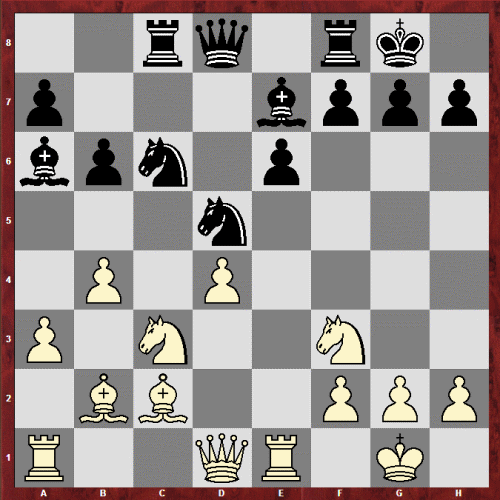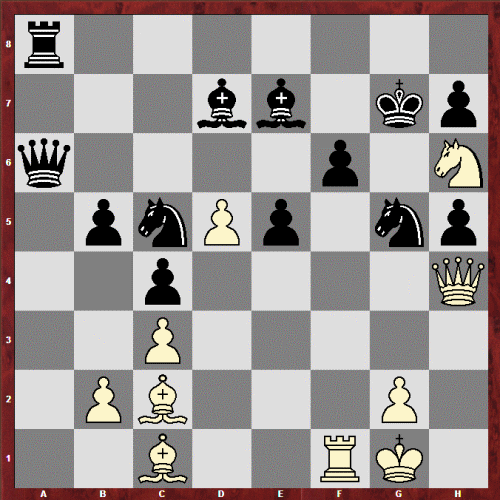Chess Puzzle with FIDE Master Dennis Monokroussos
A new World Chess Championship match opens this Thursday (November 7) with play beginning on Saturday (November 9). This contest between world champion Viswanathan Anand and his young challenger, Magnus Carlsen, is one of the most eagerly awaited championship matches in chess history, and I hope all of you will spend some time following the action over the next few weeks. (It will be covered on many websites, including my personal blog.) It will be a clash of generations, styles, and of two different approaches to the game, and that ought to make for a very dynamic and exciting match.
To start getting ready for the match, let’s throw in a bonus puzzle this week – one for each of the contestants.
First, here is one from a game played by the champion, Viswanathan Anand. This was played in 1987, back when both he and his opponent, the British super-grandmaster Michael Adams, were still in their teens. Adams has just played his knight from f6 to d5, and while that’s usually a pretty good move in positions like this, putting the knight on a nice central square and blockading the d-pawn, it’s a big mistake here. The first move is obvious, and it wouldn’t have missed Adams’ attention either. The main point is a finesse afterwards, and you must find that too to get full credit.

Anand, Viswanathan – Adams, Michael Lloyds Banks op 11th London 1987
Next up, a chess puzzle feature a game from Magnus Carlsen. Carlsen is still quite young – he’s just 22 – but this position comes from a chess match played when he was only around 12 and a half years old, about half a year before becoming a grandmaster. White has a monster attack going, but as he has sacrificed a piece he’d better have something good. How did Carlsen crash through?

Carlsen, Magnus – Harestad, Hans Krogh Politiken Cup 25th Copenhagen 2003
Please go ahead and discuss below. What do you think? Add your opinion and we’ll take a look next week at how the game ended and why.


I don’t have an answer for the Anand puzzle, but for the Carlsen one I see:
1. Qxg5+ fxg5
2. Rf7+ Kxh6
3. Rxh7#
I don’t have an answer for the Anand puzzle, but for the Carlsen one I see:
1. Qxg5+ fxg5
2. Rf7+ Kxg6
If 2…Kh8. 3. Rxh7# is mate on the spot.
2…Kxh6
3. Bxg5+! Here, I don’t see an obvious mate if Kxg5 but I’m sure it’s not safe.
3…Bxg5 and finally, 4. Rxh7# and Black’s own pieces are ‘smothering’ him in.
1.b5 fork wins a piece. Adams must have tough 1…Nxc3 “Queen-check” had this covered, but it doesn’t work since 2.Qd3 threatens mate and protects b5 again.
Anand:
1.b5 Nxc3 2.Qd3! (threatening mate and defending b5. This is what Adams missed I assume) 2…g6 3.Bxc3 and black loses either the bishop or knight.
@Jeff – You definitely got the correct first move on the Carlsen puzzle. I believe you have a typo (2…Kxg6) when you intended 2…Kxh6. The g6 square is of course off limits due to white’s c2-bishop. Also, you analyze 3.Bxg5+ after 2…Kxh6, but you already noted the one-move mate 3. Rxh7# in your earlier post.
If black rejects the queen sac, he loses on the spot anyway:
1…Kh8 2. Nf7#
1…Kf8 2. Qg8#
On the Anand puzzle, 1. b5! wins. Black was probably counting on the in-between 1…Nxc3 to hold the balance, as it is a forcing move (threatening white’s queen). However, white has the even more forcing 2. Qd3! which both threatens mate on h7 and protects the b5 pawn. After 2…g6 or 2…f5 to prevent mate, white plays 3. Bxc3 to restore the material balance, while maintaining the pawn fork on b5. Black must drop a piece.
Another black try after 2. Qd3 is 2…Ne4 3. Qxe4 f5, but 4. Qxe6+ followed by 5. bxa6 still wins.
In the Anand-Adams game I highly doubt that after 1.b5 Nxc3 that 2.Qd3 is the “finesse” that Adams missed. It’s too easy for a player of Adams’ caliber to miss. I’m sure there is some further tricks by black that require further accuracy by white.
I believe that the 1.b5 Nxc3 2.Qd3 is the critical sequence, but I think this is just the basic starting point of the tactic, with the alluded finesse still to come. Now quite sure what it is yet though…
@cheVelle – In 1987 Mickey Adams was a teenager, so the fact that he blundered is not inconceivable. Since the thread has been dormant for 2 weeks, I will take the liberty of mentioning that in fact the game continued 15. b5 Nxc3 16. Qd3 g6 17. Bxc3 Qc7 18. bxa6 Na5 19. Bxa5 Black resigns. Perhaps what Adams missed, though, is that after 18…Nb8 (threatening both the c3- and c2-bishop) white has 19. Re3 +-.
Haha, shouldn’t you be charging for that kind of kngw?edoel!